Financial Performance Analysis of Wesfarmers & Woolworths Ltd
VerifiedAdded on 2023/06/07
|18
|3691
|110
Report
AI Summary
This report provides a financial analysis of Wesfarmers Ltd and Woolworths Ltd, two companies listed on the Australian Stock Exchange (ASX), for the years 2016 and 2017. It includes an introduction to both companies, their industry positioning, and an overview of their financial statements (profit and loss account, balance sheet, and cash flow statement). The report highlights the companies' progress and performance over the two years, based on ratio analysis covering profitability, efficiency, liquidity, gearing, and investment ratios, with a discussion on each ratio's performance for both companies.

Acco ntin oru g f
Mana ementg
eci ionD s s
Mana ementg
eci ionD s s
Paraphrase This Document
Need a fresh take? Get an instant paraphrase of this document with our AI Paraphraser
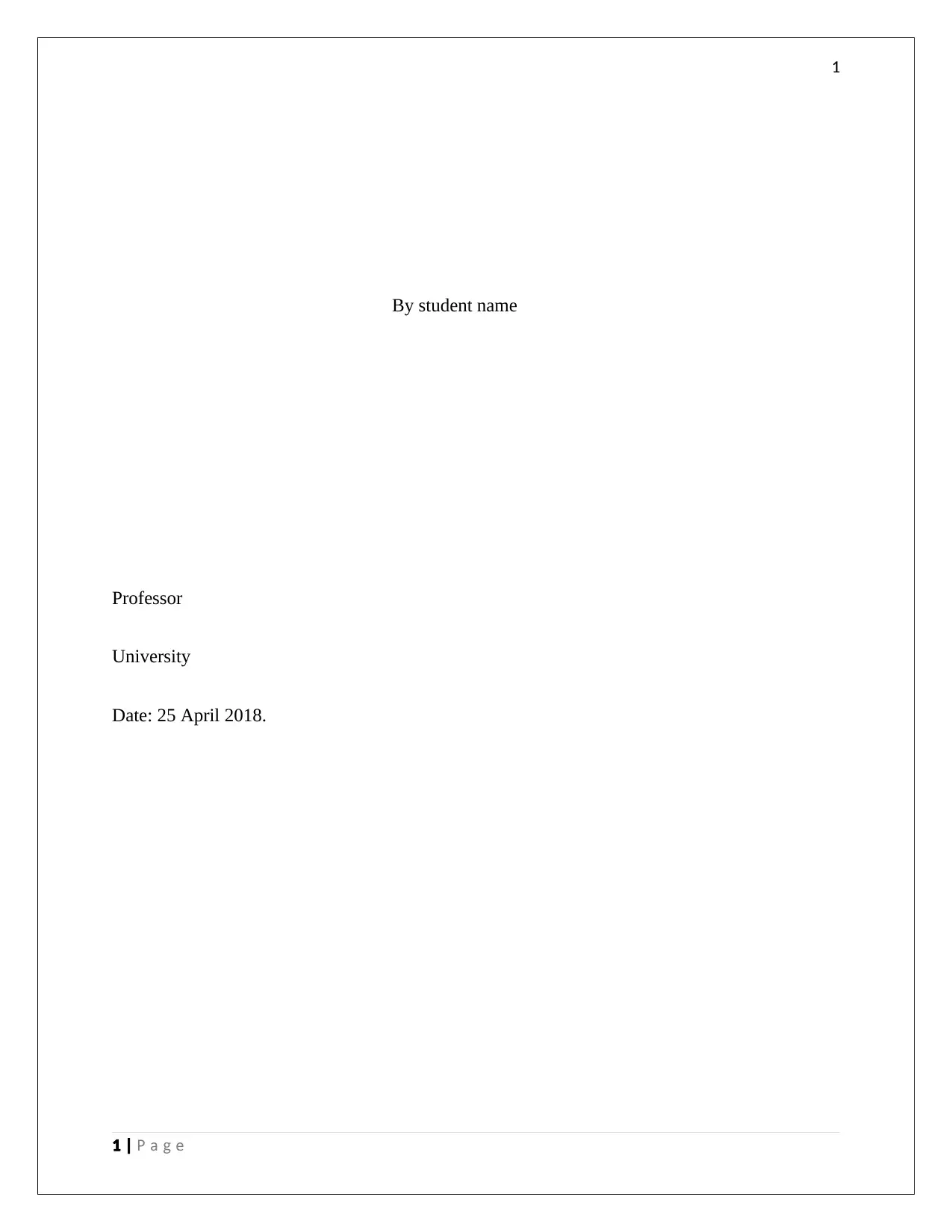
1
By student name
Professor
University
Date: 25 April 2018.
1 | P a eg
By student name
Professor
University
Date: 25 April 2018.
1 | P a eg
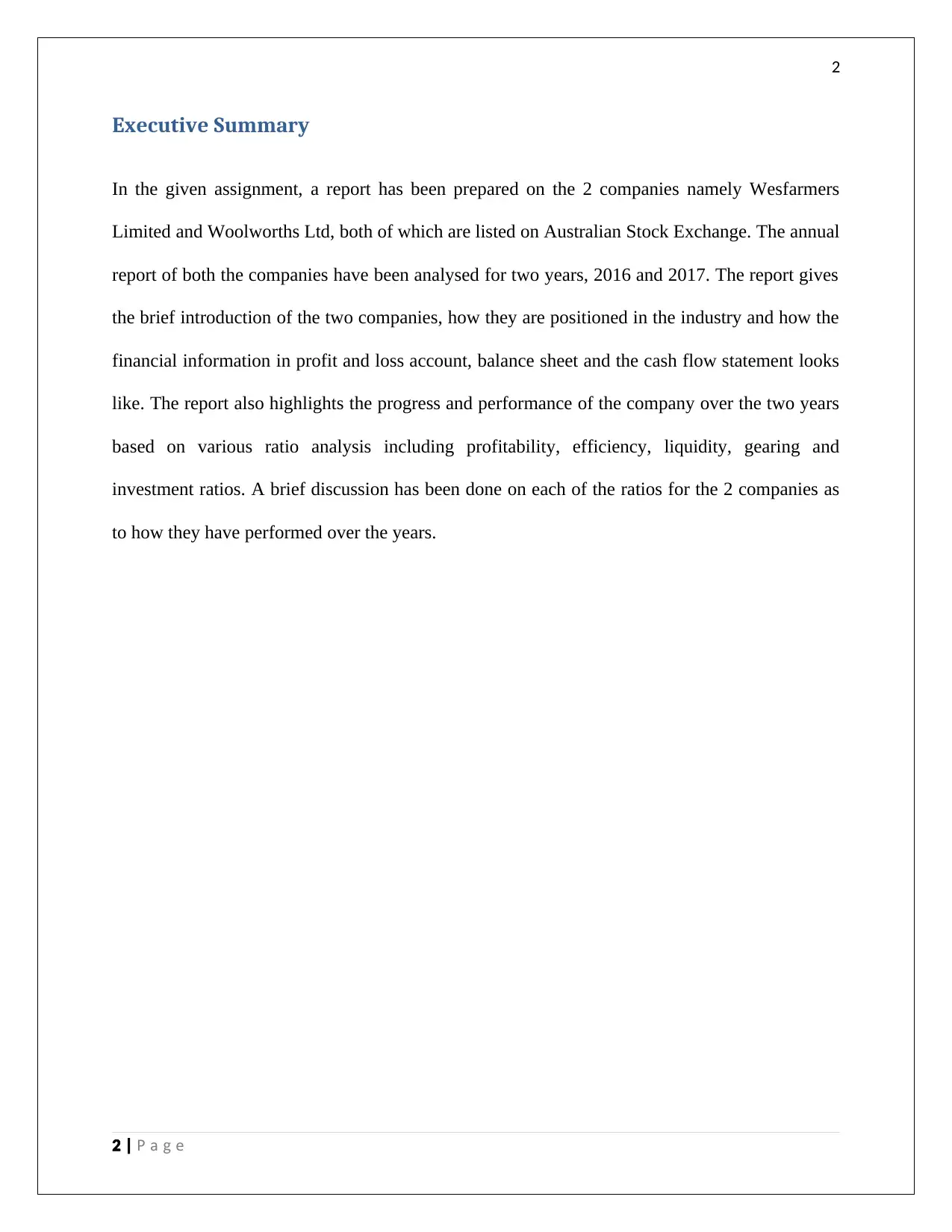
2
Executive Summary
In the given assignment, a report has been prepared on the 2 companies namely Wesfarmers
Limited and Woolworths Ltd, both of which are listed on Australian Stock Exchange. The annual
report of both the companies have been analysed for two years, 2016 and 2017. The report gives
the brief introduction of the two companies, how they are positioned in the industry and how the
financial information in profit and loss account, balance sheet and the cash flow statement looks
like. The report also highlights the progress and performance of the company over the two years
based on various ratio analysis including profitability, efficiency, liquidity, gearing and
investment ratios. A brief discussion has been done on each of the ratios for the 2 companies as
to how they have performed over the years.
2 | P a eg
Executive Summary
In the given assignment, a report has been prepared on the 2 companies namely Wesfarmers
Limited and Woolworths Ltd, both of which are listed on Australian Stock Exchange. The annual
report of both the companies have been analysed for two years, 2016 and 2017. The report gives
the brief introduction of the two companies, how they are positioned in the industry and how the
financial information in profit and loss account, balance sheet and the cash flow statement looks
like. The report also highlights the progress and performance of the company over the two years
based on various ratio analysis including profitability, efficiency, liquidity, gearing and
investment ratios. A brief discussion has been done on each of the ratios for the 2 companies as
to how they have performed over the years.
2 | P a eg
⊘ This is a preview!⊘
Do you want full access?
Subscribe today to unlock all pages.

Trusted by 1+ million students worldwide
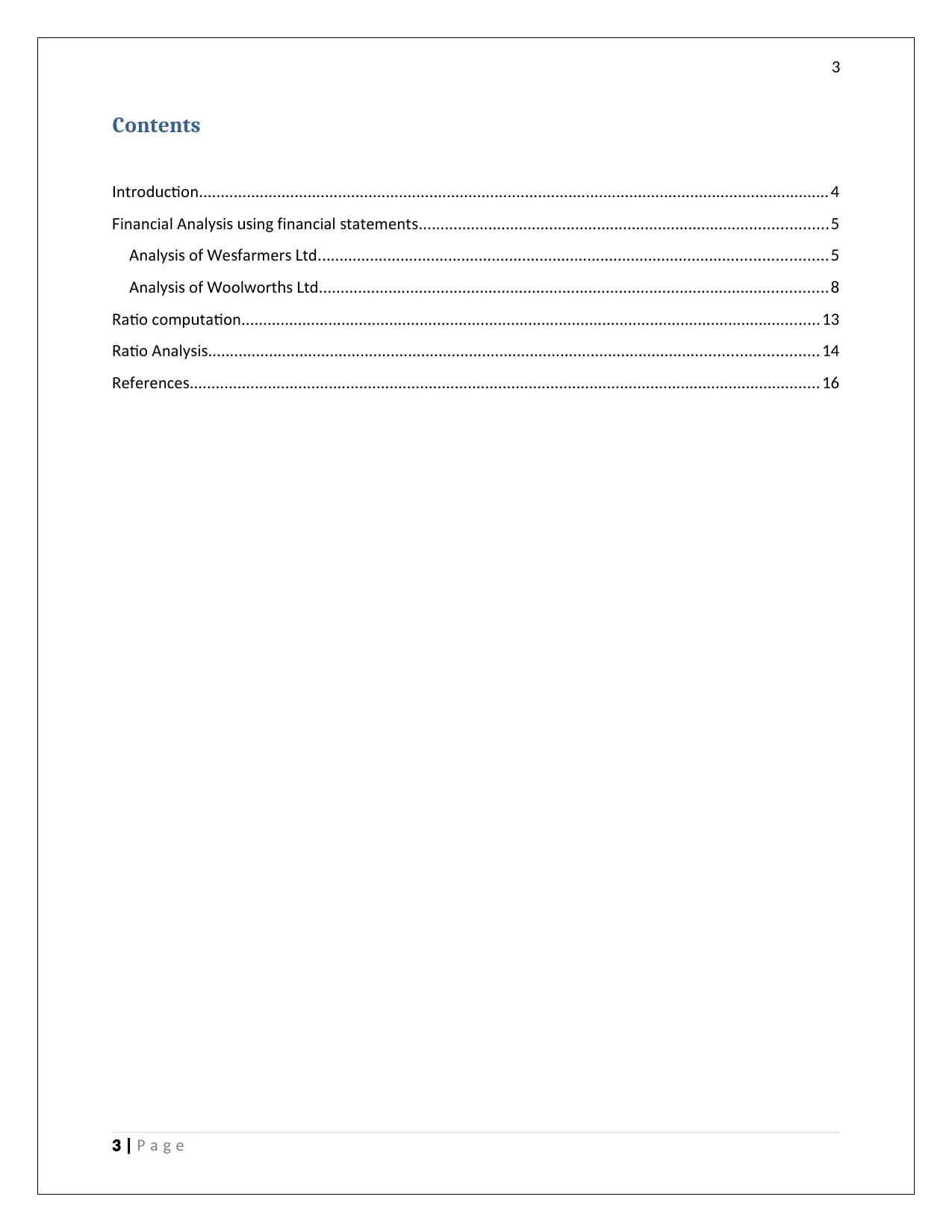
3
Contents
ntrod ctionI u .................................................................................................................................................4
inancial Anal i in inancial tatementF ys s us g f s s..............................................................................................5
Anal i o e armer tdys s f W sf s L .....................................................................................................................5
Anal i o ool ort tdys s f W w hs L .....................................................................................................................8
atio comp tationR u .....................................................................................................................................13
atio Anal iR ys s............................................................................................................................................14
e erenceR f s.................................................................................................................................................16
3 | P a eg
Contents
ntrod ctionI u .................................................................................................................................................4
inancial Anal i in inancial tatementF ys s us g f s s..............................................................................................5
Anal i o e armer tdys s f W sf s L .....................................................................................................................5
Anal i o ool ort tdys s f W w hs L .....................................................................................................................8
atio comp tationR u .....................................................................................................................................13
atio Anal iR ys s............................................................................................................................................14
e erenceR f s.................................................................................................................................................16
3 | P a eg
Paraphrase This Document
Need a fresh take? Get an instant paraphrase of this document with our AI Paraphraser
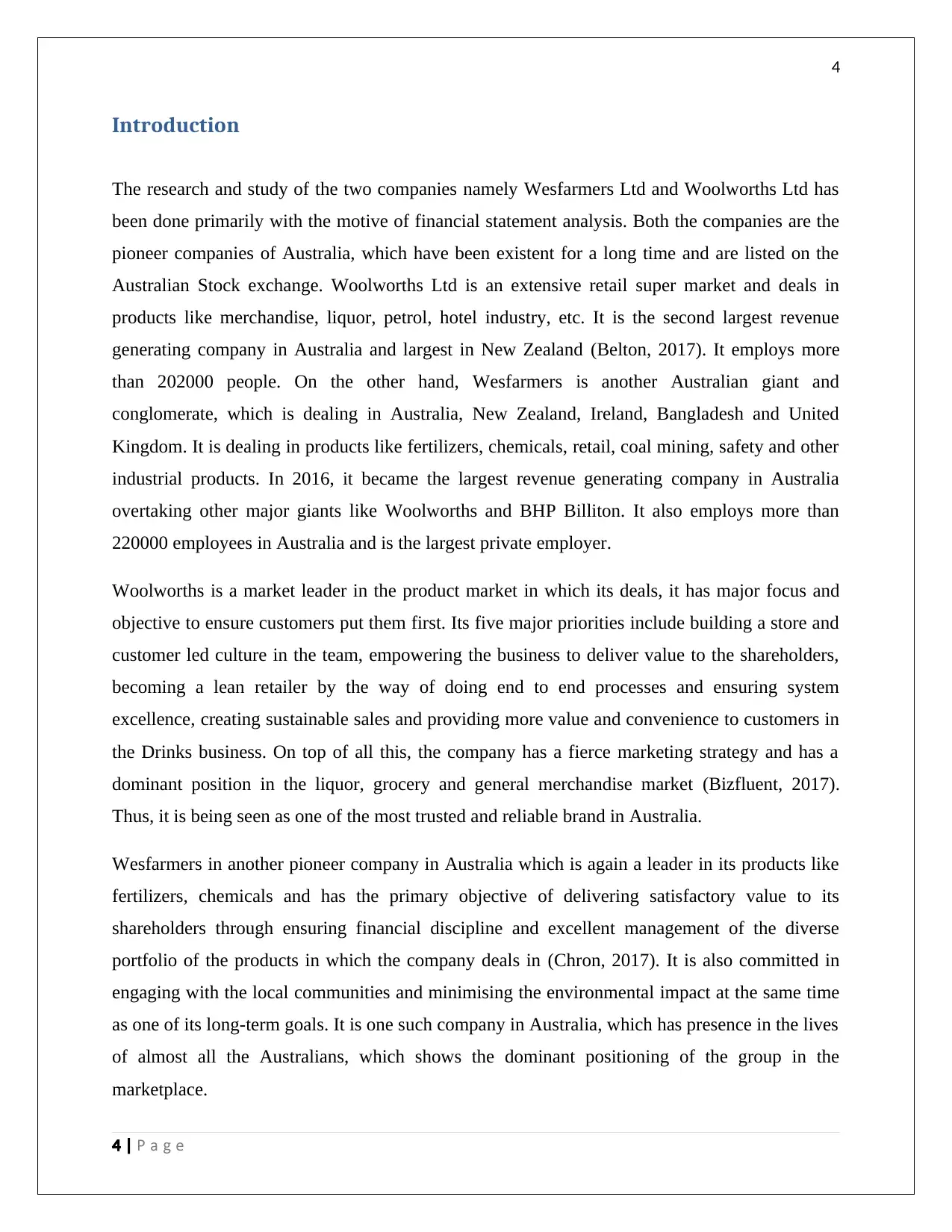
4
Introduction
The research and study of the two companies namely Wesfarmers Ltd and Woolworths Ltd has
been done primarily with the motive of financial statement analysis. Both the companies are the
pioneer companies of Australia, which have been existent for a long time and are listed on the
Australian Stock exchange. Woolworths Ltd is an extensive retail super market and deals in
products like merchandise, liquor, petrol, hotel industry, etc. It is the second largest revenue
generating company in Australia and largest in New Zealand (Belton, 2017). It employs more
than 202000 people. On the other hand, Wesfarmers is another Australian giant and
conglomerate, which is dealing in Australia, New Zealand, Ireland, Bangladesh and United
Kingdom. It is dealing in products like fertilizers, chemicals, retail, coal mining, safety and other
industrial products. In 2016, it became the largest revenue generating company in Australia
overtaking other major giants like Woolworths and BHP Billiton. It also employs more than
220000 employees in Australia and is the largest private employer.
Woolworths is a market leader in the product market in which its deals, it has major focus and
objective to ensure customers put them first. Its five major priorities include building a store and
customer led culture in the team, empowering the business to deliver value to the shareholders,
becoming a lean retailer by the way of doing end to end processes and ensuring system
excellence, creating sustainable sales and providing more value and convenience to customers in
the Drinks business. On top of all this, the company has a fierce marketing strategy and has a
dominant position in the liquor, grocery and general merchandise market (Bizfluent, 2017).
Thus, it is being seen as one of the most trusted and reliable brand in Australia.
Wesfarmers in another pioneer company in Australia which is again a leader in its products like
fertilizers, chemicals and has the primary objective of delivering satisfactory value to its
shareholders through ensuring financial discipline and excellent management of the diverse
portfolio of the products in which the company deals in (Chron, 2017). It is also committed in
engaging with the local communities and minimising the environmental impact at the same time
as one of its long-term goals. It is one such company in Australia, which has presence in the lives
of almost all the Australians, which shows the dominant positioning of the group in the
marketplace.
4 | P a eg
Introduction
The research and study of the two companies namely Wesfarmers Ltd and Woolworths Ltd has
been done primarily with the motive of financial statement analysis. Both the companies are the
pioneer companies of Australia, which have been existent for a long time and are listed on the
Australian Stock exchange. Woolworths Ltd is an extensive retail super market and deals in
products like merchandise, liquor, petrol, hotel industry, etc. It is the second largest revenue
generating company in Australia and largest in New Zealand (Belton, 2017). It employs more
than 202000 people. On the other hand, Wesfarmers is another Australian giant and
conglomerate, which is dealing in Australia, New Zealand, Ireland, Bangladesh and United
Kingdom. It is dealing in products like fertilizers, chemicals, retail, coal mining, safety and other
industrial products. In 2016, it became the largest revenue generating company in Australia
overtaking other major giants like Woolworths and BHP Billiton. It also employs more than
220000 employees in Australia and is the largest private employer.
Woolworths is a market leader in the product market in which its deals, it has major focus and
objective to ensure customers put them first. Its five major priorities include building a store and
customer led culture in the team, empowering the business to deliver value to the shareholders,
becoming a lean retailer by the way of doing end to end processes and ensuring system
excellence, creating sustainable sales and providing more value and convenience to customers in
the Drinks business. On top of all this, the company has a fierce marketing strategy and has a
dominant position in the liquor, grocery and general merchandise market (Bizfluent, 2017).
Thus, it is being seen as one of the most trusted and reliable brand in Australia.
Wesfarmers in another pioneer company in Australia which is again a leader in its products like
fertilizers, chemicals and has the primary objective of delivering satisfactory value to its
shareholders through ensuring financial discipline and excellent management of the diverse
portfolio of the products in which the company deals in (Chron, 2017). It is also committed in
engaging with the local communities and minimising the environmental impact at the same time
as one of its long-term goals. It is one such company in Australia, which has presence in the lives
of almost all the Australians, which shows the dominant positioning of the group in the
marketplace.
4 | P a eg
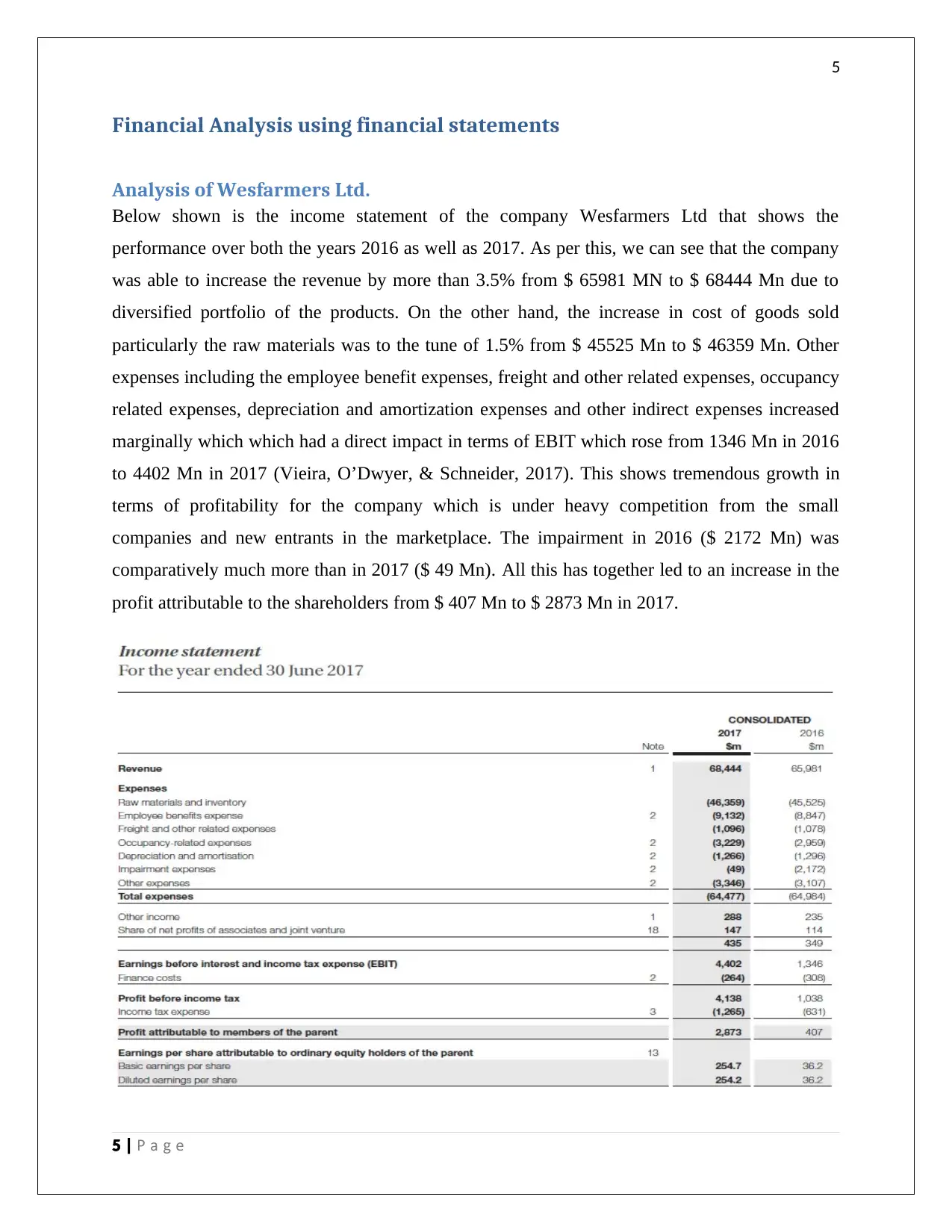
5
Financial Analysis using financial statements
Analysis of Wesfarmers Ltd.
Below shown is the income statement of the company Wesfarmers Ltd that shows the
performance over both the years 2016 as well as 2017. As per this, we can see that the company
was able to increase the revenue by more than 3.5% from $ 65981 MN to $ 68444 Mn due to
diversified portfolio of the products. On the other hand, the increase in cost of goods sold
particularly the raw materials was to the tune of 1.5% from $ 45525 Mn to $ 46359 Mn. Other
expenses including the employee benefit expenses, freight and other related expenses, occupancy
related expenses, depreciation and amortization expenses and other indirect expenses increased
marginally which which had a direct impact in terms of EBIT which rose from 1346 Mn in 2016
to 4402 Mn in 2017 (Vieira, O’Dwyer, & Schneider, 2017). This shows tremendous growth in
terms of profitability for the company which is under heavy competition from the small
companies and new entrants in the marketplace. The impairment in 2016 ($ 2172 Mn) was
comparatively much more than in 2017 ($ 49 Mn). All this has together led to an increase in the
profit attributable to the shareholders from $ 407 Mn to $ 2873 Mn in 2017.
5 | P a eg
Financial Analysis using financial statements
Analysis of Wesfarmers Ltd.
Below shown is the income statement of the company Wesfarmers Ltd that shows the
performance over both the years 2016 as well as 2017. As per this, we can see that the company
was able to increase the revenue by more than 3.5% from $ 65981 MN to $ 68444 Mn due to
diversified portfolio of the products. On the other hand, the increase in cost of goods sold
particularly the raw materials was to the tune of 1.5% from $ 45525 Mn to $ 46359 Mn. Other
expenses including the employee benefit expenses, freight and other related expenses, occupancy
related expenses, depreciation and amortization expenses and other indirect expenses increased
marginally which which had a direct impact in terms of EBIT which rose from 1346 Mn in 2016
to 4402 Mn in 2017 (Vieira, O’Dwyer, & Schneider, 2017). This shows tremendous growth in
terms of profitability for the company which is under heavy competition from the small
companies and new entrants in the marketplace. The impairment in 2016 ($ 2172 Mn) was
comparatively much more than in 2017 ($ 49 Mn). All this has together led to an increase in the
profit attributable to the shareholders from $ 407 Mn to $ 2873 Mn in 2017.
5 | P a eg
⊘ This is a preview!⊘
Do you want full access?
Subscribe today to unlock all pages.

Trusted by 1+ million students worldwide
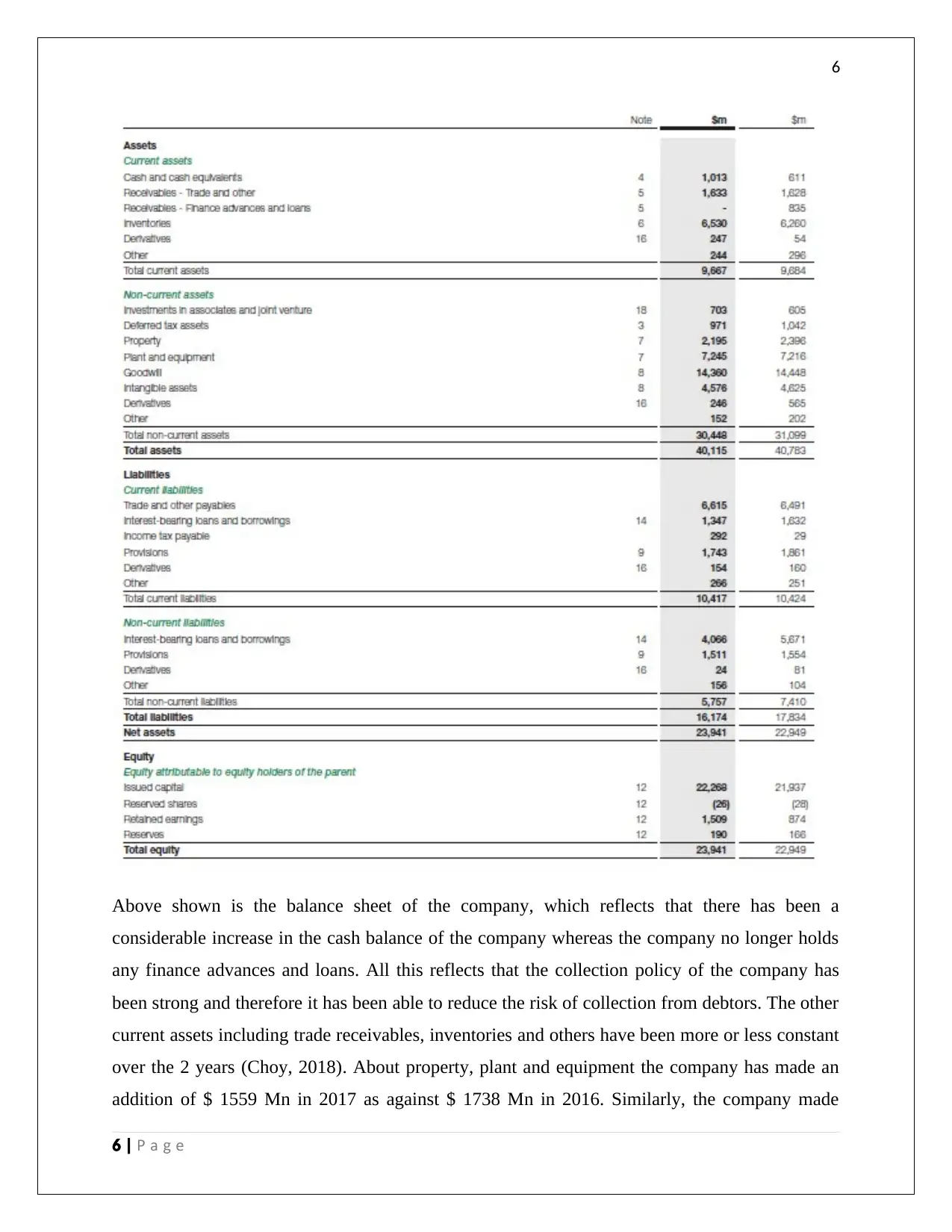
6
Above shown is the balance sheet of the company, which reflects that there has been a
considerable increase in the cash balance of the company whereas the company no longer holds
any finance advances and loans. All this reflects that the collection policy of the company has
been strong and therefore it has been able to reduce the risk of collection from debtors. The other
current assets including trade receivables, inventories and others have been more or less constant
over the 2 years (Choy, 2018). About property, plant and equipment the company has made an
addition of $ 1559 Mn in 2017 as against $ 1738 Mn in 2016. Similarly, the company made
6 | P a eg
Above shown is the balance sheet of the company, which reflects that there has been a
considerable increase in the cash balance of the company whereas the company no longer holds
any finance advances and loans. All this reflects that the collection policy of the company has
been strong and therefore it has been able to reduce the risk of collection from debtors. The other
current assets including trade receivables, inventories and others have been more or less constant
over the 2 years (Choy, 2018). About property, plant and equipment the company has made an
addition of $ 1559 Mn in 2017 as against $ 1738 Mn in 2016. Similarly, the company made
6 | P a eg
Paraphrase This Document
Need a fresh take? Get an instant paraphrase of this document with our AI Paraphraser
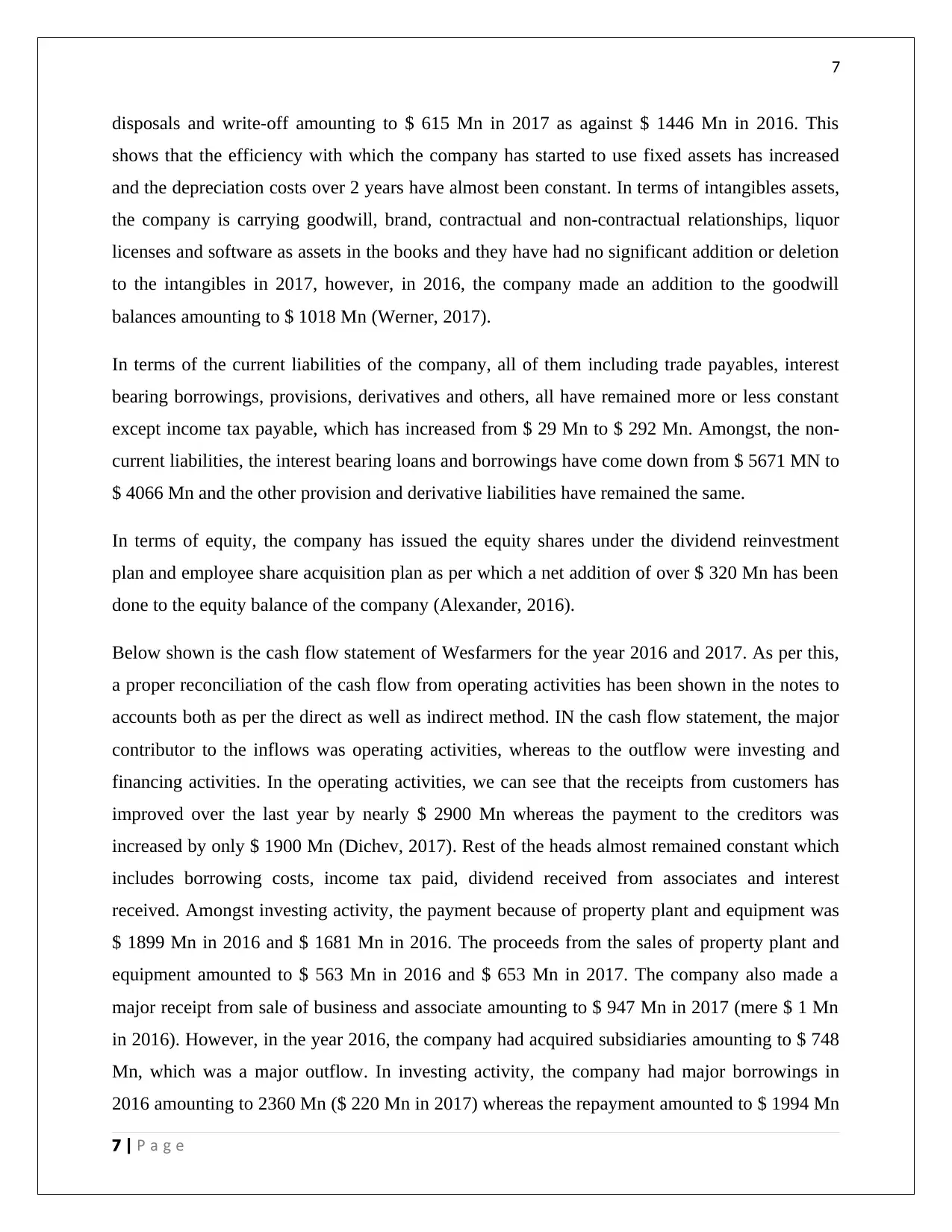
7
disposals and write-off amounting to $ 615 Mn in 2017 as against $ 1446 Mn in 2016. This
shows that the efficiency with which the company has started to use fixed assets has increased
and the depreciation costs over 2 years have almost been constant. In terms of intangibles assets,
the company is carrying goodwill, brand, contractual and non-contractual relationships, liquor
licenses and software as assets in the books and they have had no significant addition or deletion
to the intangibles in 2017, however, in 2016, the company made an addition to the goodwill
balances amounting to $ 1018 Mn (Werner, 2017).
In terms of the current liabilities of the company, all of them including trade payables, interest
bearing borrowings, provisions, derivatives and others, all have remained more or less constant
except income tax payable, which has increased from $ 29 Mn to $ 292 Mn. Amongst, the non-
current liabilities, the interest bearing loans and borrowings have come down from $ 5671 MN to
$ 4066 Mn and the other provision and derivative liabilities have remained the same.
In terms of equity, the company has issued the equity shares under the dividend reinvestment
plan and employee share acquisition plan as per which a net addition of over $ 320 Mn has been
done to the equity balance of the company (Alexander, 2016).
Below shown is the cash flow statement of Wesfarmers for the year 2016 and 2017. As per this,
a proper reconciliation of the cash flow from operating activities has been shown in the notes to
accounts both as per the direct as well as indirect method. IN the cash flow statement, the major
contributor to the inflows was operating activities, whereas to the outflow were investing and
financing activities. In the operating activities, we can see that the receipts from customers has
improved over the last year by nearly $ 2900 Mn whereas the payment to the creditors was
increased by only $ 1900 Mn (Dichev, 2017). Rest of the heads almost remained constant which
includes borrowing costs, income tax paid, dividend received from associates and interest
received. Amongst investing activity, the payment because of property plant and equipment was
$ 1899 Mn in 2016 and $ 1681 Mn in 2016. The proceeds from the sales of property plant and
equipment amounted to $ 563 Mn in 2016 and $ 653 Mn in 2017. The company also made a
major receipt from sale of business and associate amounting to $ 947 Mn in 2017 (mere $ 1 Mn
in 2016). However, in the year 2016, the company had acquired subsidiaries amounting to $ 748
Mn, which was a major outflow. In investing activity, the company had major borrowings in
2016 amounting to 2360 Mn ($ 220 Mn in 2017) whereas the repayment amounted to $ 1994 Mn
7 | P a eg
disposals and write-off amounting to $ 615 Mn in 2017 as against $ 1446 Mn in 2016. This
shows that the efficiency with which the company has started to use fixed assets has increased
and the depreciation costs over 2 years have almost been constant. In terms of intangibles assets,
the company is carrying goodwill, brand, contractual and non-contractual relationships, liquor
licenses and software as assets in the books and they have had no significant addition or deletion
to the intangibles in 2017, however, in 2016, the company made an addition to the goodwill
balances amounting to $ 1018 Mn (Werner, 2017).
In terms of the current liabilities of the company, all of them including trade payables, interest
bearing borrowings, provisions, derivatives and others, all have remained more or less constant
except income tax payable, which has increased from $ 29 Mn to $ 292 Mn. Amongst, the non-
current liabilities, the interest bearing loans and borrowings have come down from $ 5671 MN to
$ 4066 Mn and the other provision and derivative liabilities have remained the same.
In terms of equity, the company has issued the equity shares under the dividend reinvestment
plan and employee share acquisition plan as per which a net addition of over $ 320 Mn has been
done to the equity balance of the company (Alexander, 2016).
Below shown is the cash flow statement of Wesfarmers for the year 2016 and 2017. As per this,
a proper reconciliation of the cash flow from operating activities has been shown in the notes to
accounts both as per the direct as well as indirect method. IN the cash flow statement, the major
contributor to the inflows was operating activities, whereas to the outflow were investing and
financing activities. In the operating activities, we can see that the receipts from customers has
improved over the last year by nearly $ 2900 Mn whereas the payment to the creditors was
increased by only $ 1900 Mn (Dichev, 2017). Rest of the heads almost remained constant which
includes borrowing costs, income tax paid, dividend received from associates and interest
received. Amongst investing activity, the payment because of property plant and equipment was
$ 1899 Mn in 2016 and $ 1681 Mn in 2016. The proceeds from the sales of property plant and
equipment amounted to $ 563 Mn in 2016 and $ 653 Mn in 2017. The company also made a
major receipt from sale of business and associate amounting to $ 947 Mn in 2017 (mere $ 1 Mn
in 2016). However, in the year 2016, the company had acquired subsidiaries amounting to $ 748
Mn, which was a major outflow. In investing activity, the company had major borrowings in
2016 amounting to 2360 Mn ($ 220 Mn in 2017) whereas the repayment amounted to $ 1994 Mn
7 | P a eg

8
in 2017 ($ 1424 Mn in 2016), other heads almost remaining constant. The net increase in cash
flow for the year was $ 402 Mn in 2017 as against $ 100 Mn outflow in 2016 (Goldmann, 2016).
Analysis of Woolworths Ltd.
Below shown is the profit and loss account of the company as per which the company was able
to increase the revenue by 4% from $ 53473 Mn in 2016 to $ 55475 Mn in 2017. On account of
this, the cost of sales increased only by 2.5% from $ 38538 Mn tin 2016 to $ 39739 Mn in 2017.
The other revenue, the branch expenses and other administration expenses remained more or less
constant during 2016 as well as 2017 (Heminway, 2017). The earnings before interest and tax
amounted to 1495 Mn in 2016 and $ 2326 Mn in 2017, which is nearly an increase of 70% in
profits. In addition, the earning per share of the company increased from -97.7 to 119.4 cents per
share, which shows that the company has been grown not only in terms of profits and business
but also in terms of shareholder returns.
8 | P a eg
in 2017 ($ 1424 Mn in 2016), other heads almost remaining constant. The net increase in cash
flow for the year was $ 402 Mn in 2017 as against $ 100 Mn outflow in 2016 (Goldmann, 2016).
Analysis of Woolworths Ltd.
Below shown is the profit and loss account of the company as per which the company was able
to increase the revenue by 4% from $ 53473 Mn in 2016 to $ 55475 Mn in 2017. On account of
this, the cost of sales increased only by 2.5% from $ 38538 Mn tin 2016 to $ 39739 Mn in 2017.
The other revenue, the branch expenses and other administration expenses remained more or less
constant during 2016 as well as 2017 (Heminway, 2017). The earnings before interest and tax
amounted to 1495 Mn in 2016 and $ 2326 Mn in 2017, which is nearly an increase of 70% in
profits. In addition, the earning per share of the company increased from -97.7 to 119.4 cents per
share, which shows that the company has been grown not only in terms of profits and business
but also in terms of shareholder returns.
8 | P a eg
⊘ This is a preview!⊘
Do you want full access?
Subscribe today to unlock all pages.

Trusted by 1+ million students worldwide
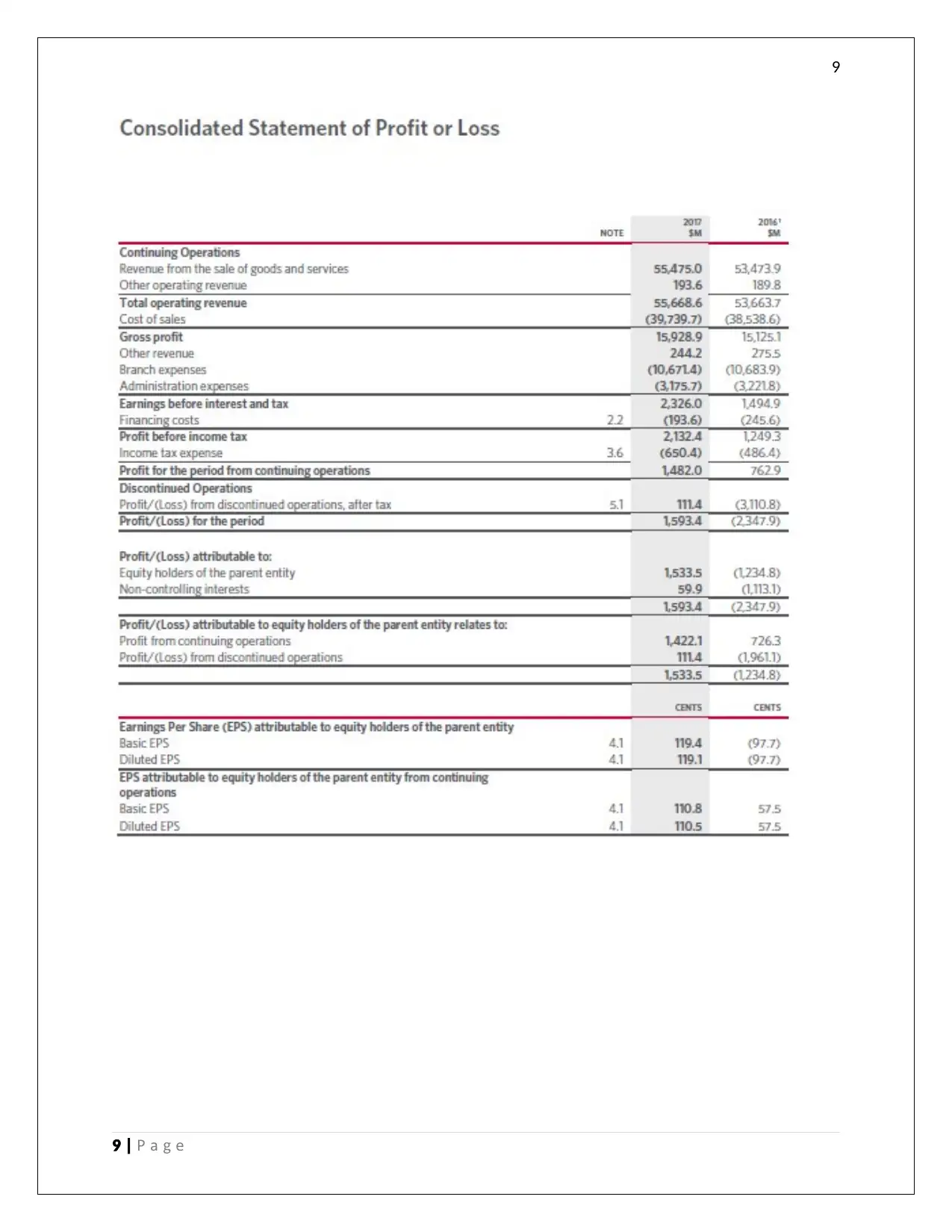
9
9 | P a eg
9 | P a eg
Paraphrase This Document
Need a fresh take? Get an instant paraphrase of this document with our AI Paraphraser

10
From the above shown consolidated balance sheet, we can see that in current assets, apart from
the inventories, rest of the assets like the cash and cash equivalents, the receivables and other
financial assets all have remained constant. The overall inventories level has come down from $
4558 MN to $ 4080 Mn, which shows the effective management of inventory levels. Amongst,
the non-current assets, there was substantial change in the balance of the property, plant and
equipment where the company made the addition of $ 1862 Mn in 2017 and $ 1842 Mn in 2016
and also made the disposals amounting to $ 111 Mn in 2017 and $ 132 Mn in 2016 (Gooley,
2016). The other non current assets like trade and other receivables, the financial assets, the
intangible assets and he deferred tax assets remained fairly constant over these 2 years. In terms
10 | P a eg
From the above shown consolidated balance sheet, we can see that in current assets, apart from
the inventories, rest of the assets like the cash and cash equivalents, the receivables and other
financial assets all have remained constant. The overall inventories level has come down from $
4558 MN to $ 4080 Mn, which shows the effective management of inventory levels. Amongst,
the non-current assets, there was substantial change in the balance of the property, plant and
equipment where the company made the addition of $ 1862 Mn in 2017 and $ 1842 Mn in 2016
and also made the disposals amounting to $ 111 Mn in 2017 and $ 132 Mn in 2016 (Gooley,
2016). The other non current assets like trade and other receivables, the financial assets, the
intangible assets and he deferred tax assets remained fairly constant over these 2 years. In terms
10 | P a eg
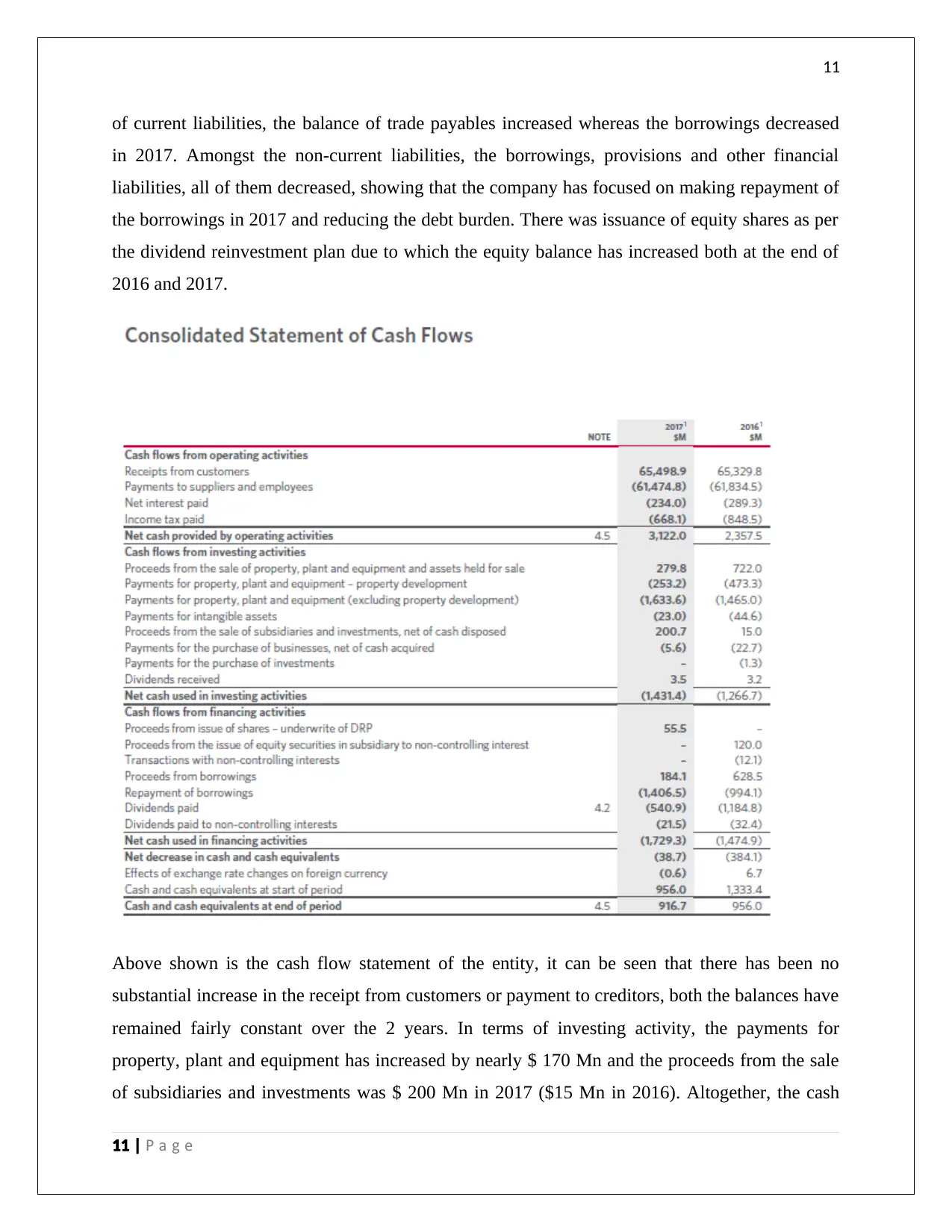
11
of current liabilities, the balance of trade payables increased whereas the borrowings decreased
in 2017. Amongst the non-current liabilities, the borrowings, provisions and other financial
liabilities, all of them decreased, showing that the company has focused on making repayment of
the borrowings in 2017 and reducing the debt burden. There was issuance of equity shares as per
the dividend reinvestment plan due to which the equity balance has increased both at the end of
2016 and 2017.
Above shown is the cash flow statement of the entity, it can be seen that there has been no
substantial increase in the receipt from customers or payment to creditors, both the balances have
remained fairly constant over the 2 years. In terms of investing activity, the payments for
property, plant and equipment has increased by nearly $ 170 Mn and the proceeds from the sale
of subsidiaries and investments was $ 200 Mn in 2017 ($15 Mn in 2016). Altogether, the cash
11 | P a eg
of current liabilities, the balance of trade payables increased whereas the borrowings decreased
in 2017. Amongst the non-current liabilities, the borrowings, provisions and other financial
liabilities, all of them decreased, showing that the company has focused on making repayment of
the borrowings in 2017 and reducing the debt burden. There was issuance of equity shares as per
the dividend reinvestment plan due to which the equity balance has increased both at the end of
2016 and 2017.
Above shown is the cash flow statement of the entity, it can be seen that there has been no
substantial increase in the receipt from customers or payment to creditors, both the balances have
remained fairly constant over the 2 years. In terms of investing activity, the payments for
property, plant and equipment has increased by nearly $ 170 Mn and the proceeds from the sale
of subsidiaries and investments was $ 200 Mn in 2017 ($15 Mn in 2016). Altogether, the cash
11 | P a eg
⊘ This is a preview!⊘
Do you want full access?
Subscribe today to unlock all pages.

Trusted by 1+ million students worldwide
1 out of 18
Related Documents
Your All-in-One AI-Powered Toolkit for Academic Success.
+13062052269
info@desklib.com
Available 24*7 on WhatsApp / Email
![[object Object]](/_next/static/media/star-bottom.7253800d.svg)
Unlock your academic potential
Copyright © 2020–2026 A2Z Services. All Rights Reserved. Developed and managed by ZUCOL.





